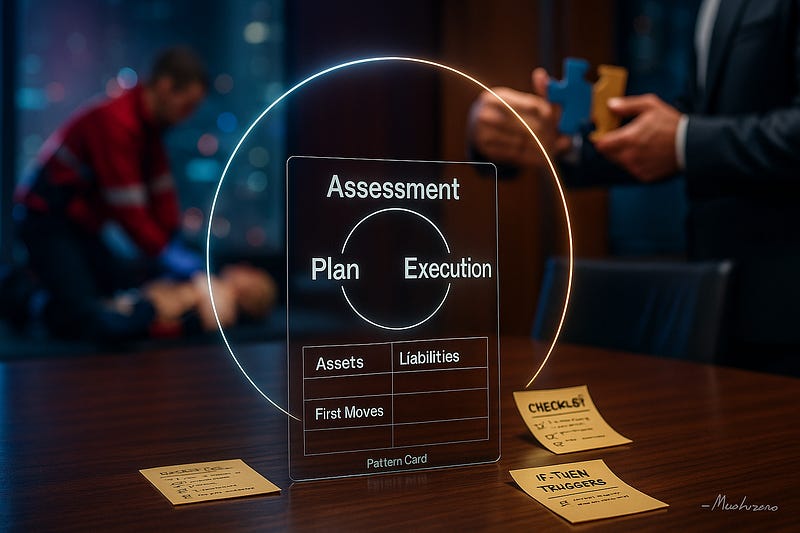Vibe Management: Patterns Over Promises
Speed isn’t a mood; it’s an operating system. Most teams try to feel fast by shipping more meetings, more dashboards, more “quick syncs.” What they build instead is latency. Vibe management is the opposite move: set a small number of explicit patterns that reduce social friction and decision drag, then let the vibe — calm, competent, honest — do the heavy lifting.
Here’s the pattern I use everywhere:
Assessment → Plan → Execution (APE), wrapped in short review cycles.
And one compact grammar for action: assets, liabilities, first moves.
Assets: what creates leverage (capabilities, data, trust, budget, time).
Liabilities: what creates drag or danger (risks, constraints, failure modes).
First moves: the smallest high-yield actions that change the state right now.
Once a team shares this grammar, the vibe changes. People stop debating abstractions and start trading concrete moves.
Three quick scenes
1) The Emergency
When someone collapses, you don’t “align stakeholders.” You identify liabilities (blocked airway, bleeding, time), match assets (people, protocol, AED), and take the first move. The vibe is calm urgency because the pattern is known. In business, most crises are quieter but structurally identical: establish what’s true, act on the highest-leverage step, review fast, repeat.
2) The New Engagement
New customer, new surface area, new risks. Instead of an ocean of slides, publish a one-page Pattern Card: goal, assets, liabilities, first moves, metrics, stop-rules, review cadence. Run one to three bounded experiments. Talk about measured learning, not vibes about vibes. Surprisingly, momentum shows up anyway — because ambiguity left the room.
3) The Partnership
Partnerships work when complementarities are real and tradable. You expand the pie by putting multiple issues on the table (scope, data access, SLAs, go-to-market rights) and crafting packages you can live with. That mechanics-first approach creates a cooperative vibe. Not the other way around.
The small levers behind big outcomes
Language beats pep talks. Give people a shared vocabulary — assets, liabilities, first moves — and the meetings get shorter. Fewer hedges, more movement.
Cadence beats heroics. A weekly 30-minute OODA-style review replaces performative urgency with predictable tempo. The vibe settles; throughput rises.
Checklists beat charisma. For steps that must not be missed, make the list public and short. It’s a social contract, not a suggestion.
If–then triggers beat “nudges.” “If security review exceeds five days, then escalate to X.” Friction drops because no one argues about when to act.
Relational governance beats legal maximalism. Write the contract you need — and then agree on how you’ll behave when the contract is silent. That’s where most partnerships live.
A minimal API for vibe management
set_intent(“calm speed, no surprises”) — Name the felt state you’re optimizing.
prime_language(assets, liabilities, first_moves) — Make the grammar explicit.
artifact(pattern_card) — Instantiate intent in a one-page object.
cadence(weekly_review_30min) — Put tempo on the calendar, not in the hallway.
safety(checklists, stop_rules) — Lower the social cost of surfacing reality.
negotiate(multi_issue_packages) — Create room for trades, not ultimatums.
measure(ttfm, hit_rate, surfacing_latency, reuse_rate) — Keep the vibe honest.
30 days to a different vibe
Week 1: Publish a Pattern Card for one high-value initiative.
Week 2: Add if–then triggers for the three blockers you already know.
Week 3: Run a 30-minute weekly review — no slides, just state change: “what moved?”
Week 4: Clone the pattern to a second team. Track time-to-first-move and issue-surfacing latency. If those improve, the vibe is working.
The trap is thinking culture changes first and results follow. In practice, patterns change behavior; behavior changes outcomes; outcomes change the vibe. Start with patterns. The rest tends to align.



